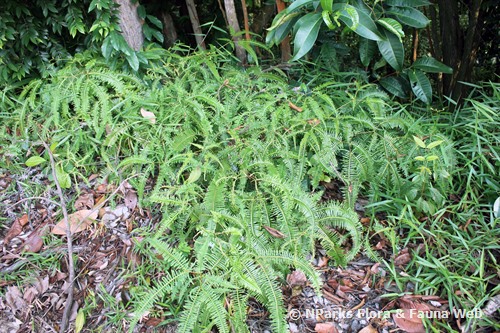.jpg)
Back
Dicranopteris curranii Copel.
| Family Name: | Gleicheniaceae |
| Synonyms: | Dicranopteris gigantea Ching, Dicranopteris lessonii (A.Rich.) Ching, Gleichenia dichotoma var. malayana Christ, Gleichenia venosa (Copel.) Holttum, Sticherus venosus Copel. |
Dicranopteris curranii is a terrestrial fern native to Singapore. It is large, strongly upright, fast growing and can quickly forming large dense bushes known as thickets in exposed sites. The foliage branch out several times to form deeply lobed pinnatifid leaflets with greyish blue underside. The sori are round on either sides of the midrib.
Name
Classifications and Characteristics
| Plant Division | Ferns & Lycophytes (Non-Seed Vascular Plants) (Fern) |
|---|---|
| Plant Growth Form | Herbaceous Plant |
Biogeography
| Native Distribution | Yunan to Malesia, Fiji Islands |
|---|---|
| Native Habitat | Terrestrial (Secondary Rainforest, Primary Rainforest, Disturbed Area / Open Ground) |
| Preferred Climate Zone | Tropical |
| Local Conservation Status | Native to Singapore (Least Concern (LC)) |
Description and Ethnobotany
| Growth Form | It is a large, upright fern with creeping rhizomes which forms thickets, large dense bushes easily. |
|---|---|
| Foliage | The foliage branches out several times equally. The ultimate branch measures about 40 cm long, 12 cm wide, bears deeply lobed, pinnatifid leaflets. It has a greyish-blue underside, pinkish hairs may be found on the veins. |
| Reproductive Parts - non-flowering plant | The sori are round, produced on either sides of the midrib in a single line. |
| Others - Plant Morphology | The rhizomes are long-creeping, 3 - 5 mm in diameter, covered in dark brown stiff hairs. |
| Habitat | Occurs in thickets from sea level up to 1500m. <1,2> |
| Similar | Dicranopteris curranii and Dicranopteris linearisshow similarities. D. curranii is significantly larger than D. linearis in terms of its size and individual fronds. The former is strongly erect unlike D. linearis which tend to be limp. |
| Cultivation | It can be propagated through rhizomes and spores |
Plant Care and Propagation
| Light Preference | Full Sun, Semi-Shade |
|---|---|
| Water Preference | Little Water, Moderate Water |
| Plant Growth Rate | Fast to Moderate |
| Rootzone Tolerance | Easy to Grow, Fertile Loamy Soils, Moist Soils, Well-Drained Soils |
| Propagation Method | Storage Organ (Rhizome), Spore |
Foliar
| Foliage Retention | Evergreen |
|---|---|
| Mature Foliage Colour(s) | Green, Green - Bluish Green |
| Foliar Type | Compound (Even-Pinnate) |
| Foliar Shape(s) | Non-Palm Foliage (Linear, Oblong) |
| Foliar Margin | Pinnately Lobed / Pinnatifid |
| Foliar Apex - Tip | Acuminate, Retuse, Rounded |
| Foliar Base | Attenuate |
Non - Foliar and Storage
| Stem Type & Modification | Herbaceous |
|---|---|
| Root Type | Underground (Fibrous Root) |
| Specialised Storage Organ(s) | Underground (Rhizome) |
References
| References | <1> Holttum, R.E. (1959). Dicranopteris. In: Holttum, R.E. (ed.) Glecheniaceae. Flora Malesiana, ser. 2, Pteridophyta, vol. 1, pt. 1, pp. 31-32. Leiden: Rijksherbarium. <2> Tagawa, M. & Iwatsuki, K. (1979). Flora of Thailand, vol. 3(1), pp. 53-54. Bangkok: The Forest Herbarium, Department of National Parks, Wildlife and Plant Conservation. |
|---|
Image Repository
Others
| Master ID | 34282 |
|---|---|
| Species ID | 8695 |
| Flora Disclaimer | The information in this website has been compiled from reliable sources, such as reference works on medicinal plants. It is not a substitute for medical advice or treatment and NParks does not purport to provide any medical advice. Readers should always consult his/her physician before using or consuming a plant for medicinal purposes. |

.jpg)
.jpg)
.jpg)
.jpg)
.jpg)

.jpg)